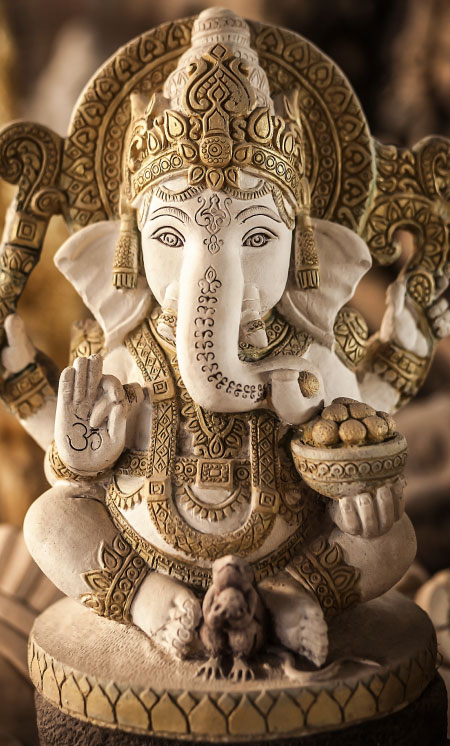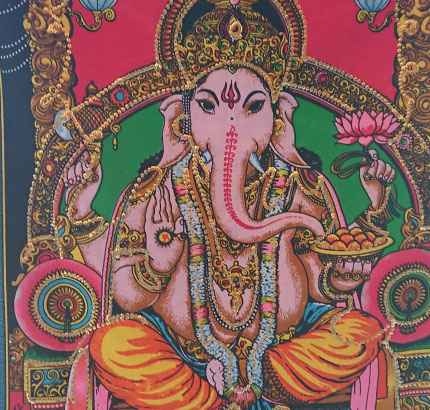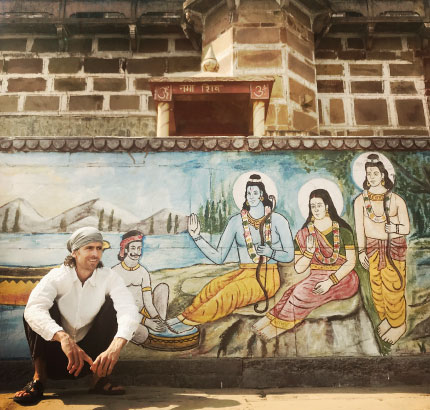
The Transformative Power of Indian Mythology
One of the ways that yoga demonstrates its amazing pragmatism and effectiveness is through the way its teachings are transmitted and encoded in mutually supportive and complementary ways. We have for example, the terse mnemonics and ultra distilled formulae of the Yoga Sūtra, the memorable poetry and dramatic setting of the relativley condensed 70-0-verse Bhagavad Gītā, considered the distillation of all the Upaniṣad-s. We also have bounteous riches of mythological stories in the many Purāṇa-s and Itihāsa-s, which elaborate and provide perennially relatable context for the human teachings of yoga.

Ancient Stories,
Timeless Wisdom
The names of these genres are highly illustrative. One way we can understand Purāṇa is as that which is ancient, yet always fresh. It is perennial but always new. The Purāṇa-s are set once upon a time, in the ever new now. While they may offer us fantastic stories of divine beings, they tell us of the perennial challenges of the human condition. And they do this in flavourful, colourful, dramatic stories that have resonated with humans for millennia.
The same is true of the itihāsa – the ‘histories’ of the Rāmāyaṇa and Mahābhārata, sometimes referred to as the ‘epics’. Itihāsa means ‘so it happened’. There is significant archeological and astronomical evidence to suggest that some of the events recounted in these great stories might well have happened as part of our history. However, itihāsa also means ‘so it happens’. Like the Purāṇa-ic stories, these great epics tell us so much about ourselves.
Journey into the Depths
I don’t know about you, but if someone comes along and starts criticising me, pointing out my weaknesses, foibles and failings, I am likely to get somewhat defensive. Humans have a refined capacity to reject input which disturbs our sense of self. We are often highly skilled at spinning justifications to deflect such critical insights and avoid looking into those shadowy parts of ourselves that we have habitually avoided. However, when enthralling stories present us with disarming facsimiles of our own strengths and weaknesses, our charms as well as our foibles, our fears as well as our failings, the teachings can penetrate our egoic defences in many beautiful ways. When the stories resonate and invite recognition, they can often encourage and empower us with new perspectives to take on the work of changing our established habits.
This work of going into the dark recesses of our psyches and affecting lasting change is of course one of the main themes of yogic mythology, which tells us of the trials and pains of the path and the skilful means to keep steadily moving forwards.
One of the many distinguishing features of Indian mythology is its comprehensiveness. We see the protagonists going through the whole spectrum of challenges and emotions. For example, in the Vālmīki-Rāmāyaṇa, we see the great heroes Rāma and Hanuman in the pits of despair. Hanuman, for example, after wowing the sky-dwelling demi-gods and denizens of the heavens by leaping across the ocean to Laṅka, only a few lines later, is contemplating suicide because he seemingly cannot accomplish his mission of finding Sītā. He persists, talks himself out of his despair and goes on to fulfil his mission with ingenuity, flair and great efficacy, but only once we have been shown, most explicitly, how suffering, doubt and despair are parts of life that we will all likely face, that it is normal and that we can find our way through it.
One of the great beauties of the itihāsa-s and purāṇa-s is how resonant and flavourful the stories are. As we apprentice ourselves to them, we can quite quickly install their bolstering messages into the fibre of our being, where they can help illustrate and elucidate for example, the pared down teachings of the yoga sūtra.
The different stories and teachings complement each other and give us a robust map and compass to navigate the adventure of our own life and practice.
One feature of Indian mythology are the many different gods and goddesses. Here, as in so many places in the realm of yoga, we encounter an apparent paradox:
From the Indian perspective, God is one, undifferentiated, total, whole, and yet we find this ultimate represented in so many forms.
This is eminently practical and very beautiful. The thousands of names and thousands of corresponding forms remind us that the name and the form are not it. THAT is beyond name and form. However, as long as we are here experiencing in this realm of name and form, deities and archetypal symbols are very practical and helpful. They can help us relate to the ineffable. They provide ways to represent that which is beyond representation.
The Sanskṛt names and forms are full of layers of rich, suggestive and instructive meaning. As we work with them, we can invite ourselves into greater resonance and attunement with the more integrated and focused awareness of the archetypal deity and so invite a loosening of the chains of our egoic limited sense of self.





Programs
SIGN UP >

Work With James
LEARN MORE >

Store
COMING SOON
Whole Life Yoga Newsletter
The place to find out first about all James’ programs and offerings, receive articles, recommendations, and access special rates for programs.
